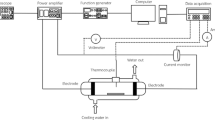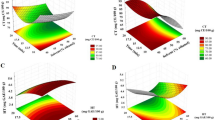Abstract
In present study, conventional, ultrasonic and microwave assisted extraction methods were compared with the aim of optimizing best fitting solvent and method, solvent concentration and digestion time for high yield of γ-oryzanol from rice bran. Petroleum ether, hexane and methanol were used to prepare extracts. Extraction yield were evaluated for giving high crude oil yield, total phenolic content (TPC) and γ-oryzanol content. Gas chromatography-mass spectrophotometry was used for the determination of γ-oryzanol concentration. The highest concentration of γ-oryzanol was detected in methanolic extracts of microwave treatment (85.0 ppm) followed by ultrasonication (82.0 ppm) and conventional extraction method (73.5 ppm). Concentration of γ-oryzanol present in the extracts was found to be directly proportional to the total phenolic content. A combination of 80 % methanolic concentration and 55 minutes digestion time of microwave treatment yielded the best extraction method for TPC and thus γ-oryzanol (105 ppm).




Similar content being viewed by others
References
Aizono Y, Funatsu M, Hayashi K, Inamasu M, Yamaguchi M (1971) Biochemical studies of rice bran lipase. Part II. Chemical properties. Agric Biol Chem 35:1973–1979
Anwar F, Qayyum HMA, Hussian AI, Iqbal S (2010) Antioxidant activity of 100 % and 80 % methanol extracts from barley seeds (Hordeum vulgare L.), stabilization of sunflower oil. Grassa y Aceites 61:237–243
AOAC (2000) Dairy Products. In: Official Methods of Analysis. Association of Analytical Chemists Inc: Gaithersburg, USA
Bhatnagar AS, Prabhakar DS, Kumar PKP, Rajan RGR, Krishna AGG (2014) Processing of commercial rice bran for the production of fat and nutraceutical rich rice brokens, rice germ and pure bran. J Food Sci Technol 58:306–311
Bicchi C, Binello A, Rubiolo P (2000) Determination of phenolic di-terpene antioxidants in rosemary (Rosmarinus officinalis L.) with different methods of extraction and analysis. Phytochem Anal 11:236–242
Dar BN, Sharma S (2011) Total phenolic content of cereal brans using conventional and microwave assisted extraction. Am J Food Technol 6(12):105–1053
Ghasemzadeh A, Hawa ZEJ, Juraimi AS, Tayebi-Meigooni A (2015) Comparative evaluation of different extraction techniques and solvents for the assay of phytochemicals and antioxidant activity of hashemi rice bran. Mol 20:10822–10838
Ghasemzadeh A, Jaafar HZ (2014a) Optimization of reflux conditions for total flavonoid and total phenolic extraction and enhanced antioxidant capacity in pandan (Pandanus amaryllifolius roxb.) using response surface methodology. Sci World J 2014:1–9
Ghasemzadeh A, Jaafar HZ, Karimi E, Rahmat A (2014b) Optimization of ultrasound-assisted extraction of flavonoid compounds and their pharmaceutical activity from curry leaf (Murraya koenigii L.) using response surface methodology. BMC Complementary Alternative Med 14(318):1–10
Gul K, Yousuf B, Singh AK, Singh P, Wani AA (2015) Rice bran nutritional value and its emerging potential for development of functional food. A review. Bioactive Carbohydrates Dietary Fibr 6:24–30
Heidtmann-Bemvenuti R, Nora NS, Badiale-Furlong E (2012) Extraction of γ-oryzanol from rice bran. Ciênc Agrotec Lavras 36(6):665–673
Holliday DL (2006) Phenolic compounds and antioxidant activity of oat bran by various Extraction methods. M. Sc. Thesis, Graduate Faculty of the Louisiana State University and Agricultural and Mechanical College
Hu W, Wells JH, Shin TS, Godber JS (1996) Comparison of isopropanol and hexane for extraction of vitamin E and oryzanols from stabilized rice bran. J Am Oil Chem Soc 73:1653–1656
Kaur H, Kaur N, Bedi O, Kaur M (2015) Conventional steaming retains tocols and γ -oryzanol better than boiling and frying in the jasmine rice variety khao dok Mali 105. Indian J Pharmacol 2(5):229–233
Kumar PP, Kumaravel S, Lalitha C (2010) Screening of antioxidant activity, total phenolics and GC-MS study of Vitex negundo. Afr J Biochem Res 4:191–195
Kwon JH, Belanger JMR, Jocelyn Pare JR, Yaylayan VA (2003) Application of microwave assisted process (MAPTM) to the fast extraction of ginseng saponin. Food Res Int 36:491–498
Li H, Chen B, Nie L, Yao S (2004) Solvent effects on focused microwave assisted extraction of polyphenolic acids from Eucommia ulmodies. Phytochem Anal 15:306–312
Miller A, Frenzel T, Schmarr HG, Engel KH (2003) Coupled liquid chromatography-gas chromatography for the rapid analysis of γ-oryzanol in rice lipids. J Chromatogr 985:403–410
Oliveira R, Oliveira V, Aracava KK, Rodrigues CEC (2012) Effects of the extraction conditions on the yield and composition of rice bran oil extracted with ethanol- a response surface approach. Food Bioproducts Processing 90:22–31
Oufnac DS, Xu Z, Sun T, Sabliov C, Prinyawiwatkul W, Godber JS (2007) Extraction of antioxidants from wheat bran using conventional solvent and microwave-assisted methods. Cereal Chem 84:125–129
Pan X, Niu G, Liu H (2003) Microwave-assisted extraction of tea polyphenols and tea caffeine from green tea leaves. Chem Eng Process 42:129–133
Pascual CSCI, Massaretto IL, Kawassaki F, Barros RMC, Noldin JA, Marquez UML (2013) Effects of parboiling, storage and cooking on the levels of tocopherols, tocotrienols and γ-oryzanol in brown rice (Oryza sativa L.). Food Res Int 50(2):676–681
Proctor A, Bowen DJ (1996) Ambient-temperature extraction of rice bran oil with hexane and isopropanol. J Am Oil Chem Soc 73:811–813
Sun T, Xu Z, Godber JS, Prinyawiwatkul W (2006) Capabilities of oat extract in inhibiting cholesterol and long chain fatty acid oxidation during heating. Cereal Chem 83:451–454
Tao W, Zhang H, Xue W, Ren L, Xia B, Zhao X (2014) Optimization of supercritical fluid extraction of oil from the fruit of Gardenia jasmininoides and its antidepressant activity. Mol 19:19350–19360
Thanonkaew AS, Wongyai S, DJ MC–D, EA D (2012) Effect of stabilization yield, quality, and antioxidant properties of cold pressed rice bran oil (Oryza sativa L.). J Food Sci Technol 48:231–236
Toma M, Vinatoru M, Paniwnyk L, Mason TJ (2001) Investigation of the effects of ultrasound on vegetal tissues during solvent extraction. Ultrason Sonochem 8:137–142
Uquiche E, Jerez M, Ortiz J (2008) Effect of pretreatment with microwaves on mechanical extraction yield and quality of vegetable oil from Chilean hazelnuts (Gevuina avellana Mol). Innovative Food Sci Emerging Technol 9:495–500
Wang W, Guo J, Zhang J, Peng J, Liu T, Xin Z (2015) Isolation identification and antioxidant activity of bound phenolic compounds present in rice bran. Food Chem 171:40–49
Acknowledgment
Present work was funded by director of Sant Longowal Institute of Engineering and Technology Longowal, Punjab-148106, India.
Author information
Authors and Affiliations
Corresponding author
Ethics declarations
Conflict of interest
The authors have no competing interests to reveal.
Additional information
Highlights
1. The amount of solvent and processing time in γ-oryzanol extraction can be reduced by applying ultrasonication and microwave treatment.2. In this study, methanolic extract of microwave treatment possessed maximum amount of γ-oryzanol as compared to conventional and ultrasonication.3. Combination of 80 % methanolic concentration and 55 minutes microwave digestion resulted extraction of highest γ-oryzanol i.e. 105 ppm.
Electronic supplementary material
ESM 1
(DOCX 1226 kb)
Rights and permissions
About this article
Cite this article
Kumar, P., Yadav, D., Kumar, P. et al. Comparative study on conventional, ultrasonication and microwave assisted extraction of γ-oryzanol from rice bran. J Food Sci Technol 53, 2047–2053 (2016). https://doi.org/10.1007/s13197-016-2175-2
Revised:
Accepted:
Published:
Issue Date:
DOI: https://doi.org/10.1007/s13197-016-2175-2




